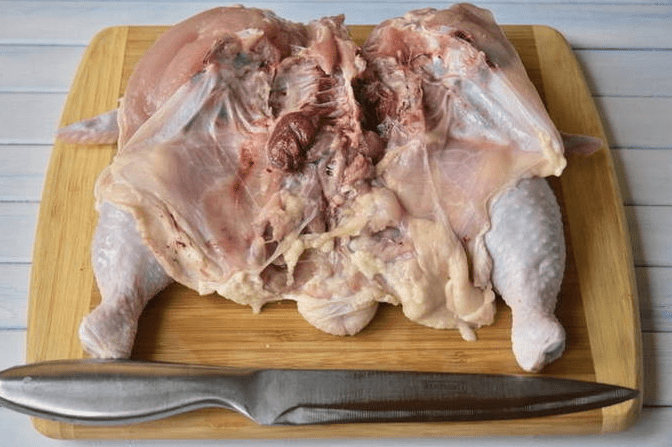What’s That Weird Thing in Your Cooked Chicken? Understanding the Oviduct Phenomenon
If you’ve ever cooked a whole chicken and discovered something unusual inside—like a coiled, flower-like structure—you’re not alone. Many people have encountered this strange sight and wondered, “What is this, and is it safe to eat?” The answer lies in the chicken’s reproductive system, specifically the oviduct.
In this article, we’ll explore what the oviduct is, why it might still be present in your chicken, and what you can do to avoid this in the future. Plus, we’ll provide tips on how to handle this situation if it happens again.
What Is the Oviduct?
The oviduct is a key part of a hen’s reproductive system. It’s a long, coiled tube where eggs are formed before being laid. The oviduct is responsible for adding the egg white (albumen), membranes, and shell to the yolk as it travels through the hen’s body. In most cases, the oviduct is removed during the evisceration process when chickens are processed for consumption.
However, in rare cases, the oviduct may be left behind, especially if the chicken was not fully eviscerated during processing. This can result in the unusual structure being present in your cooked chicken.
Why Does This Happen?
The presence of the oviduct in a cooked chicken is typically due to incomplete evisceration during the butchering process. Here are some possible reasons why this might occur:
-
Processing Errors: In large-scale poultry processing plants, chickens are eviscerated by machines. Occasionally, these machines may miss certain internal organs, leaving parts like the oviduct behind.
-
Human Oversight: In smaller-scale or manual processing operations, human error can result in incomplete removal of the internal organs.
-
Unusual Anatomy: In some cases, the oviduct may be unusually positioned or difficult to identify, leading to it being overlooked during processing.
Is It Safe to Eat?
Yes, the oviduct is technically safe to eat, as it is part of the chicken’s internal anatomy and is not harmful. However, most people find it unappetizing due to its appearance and texture. If you encounter the oviduct in your chicken, you can simply remove it and continue enjoying the rest of the meat.
What Should You Do If You Find an Oviduct in Your Chicken?
If you discover an oviduct or any other unusual organ in your cooked chicken, here’s what you can do:
-
Remove It: Use a fork or knife to carefully remove the oviduct from the chicken. It’s not harmful, but it’s understandable if you’d rather not eat it.
-
Inspect the Chicken: Check the rest of the chicken for any other leftover organs or unusual parts. This is rare, but it’s worth ensuring the chicken is fully cleaned.
-
Contact the Supplier: If you purchased the chicken from a store, consider contacting the supplier or brand. Most companies take quality control seriously and may offer a refund or replacement.
-
Report the Issue: If the chicken was processed at a local butcher or farm, let them know about the oversight so they can improve their evisceration process.
How to Avoid This in the Future
While it’s impossible to guarantee this won’t happen again, there are steps you can take to reduce the likelihood of encountering an oviduct in your chicken:
-
Buy from Reputable Brands: Larger, well-known poultry brands often have stricter quality control measures in place, reducing the chances of incomplete evisceration.
-
Inspect Before Cooking: If you’re cooking a whole chicken, take a moment to inspect the cavity before seasoning or roasting. Remove any leftover organs or tissues you find.
-
Choose Pre-Cleaned Chickens: Some stores sell chickens labeled as “fully cleaned” or “oven-ready.” These are more likely to have been thoroughly processed.
-
Support Local Farmers with Good Practices: If you buy from a local farm, ask about their processing methods. Farms with high standards for butchering are less likely to leave behind internal organs.
What the Internet Says About This Phenomenon
According to resources like Tilly’s Nest and Poultry Extension, the oviduct is a normal part of a hen’s anatomy and plays a crucial role in egg production. However, its presence in processed chicken is considered an error. Here are some additional insights from experts:
- Tilly’s Nest explains that the oviduct is part of the reproductive system and is usually removed during processing. If left behind, it’s safe but unappealing.
- Poultry Extension notes that incomplete evisceration can occur in both large-scale and small-scale operations, emphasizing the importance of quality control.
- MSD Veterinary Manual highlights that abnormalities in the reproductive system, such as cystic oviducts, can sometimes make the organ more noticeable or difficult to remove.
Final Thoughts
Finding an oviduct in your cooked chicken can be surprising, but it’s not dangerous. By understanding what it is and why it happens, you can handle the situation calmly and take steps to avoid it in the future. Whether you’re buying from a local farm or a large grocery store, inspecting your chicken before cooking is always a good practice.
Have you ever encountered something unusual in your chicken? Share your experience in the comments below, and let’s discuss how to make cooking chicken a stress-free experience for everyone!
